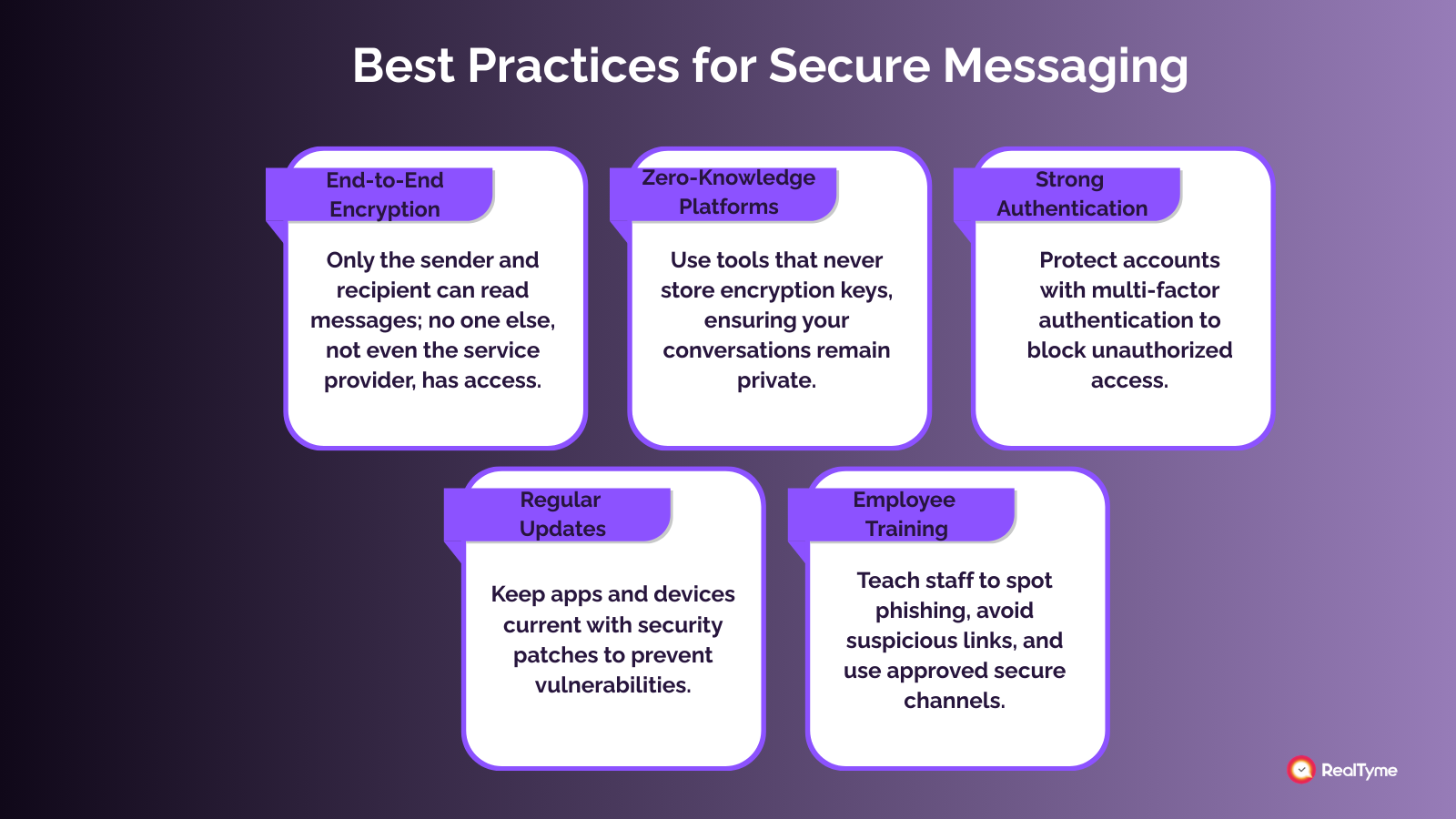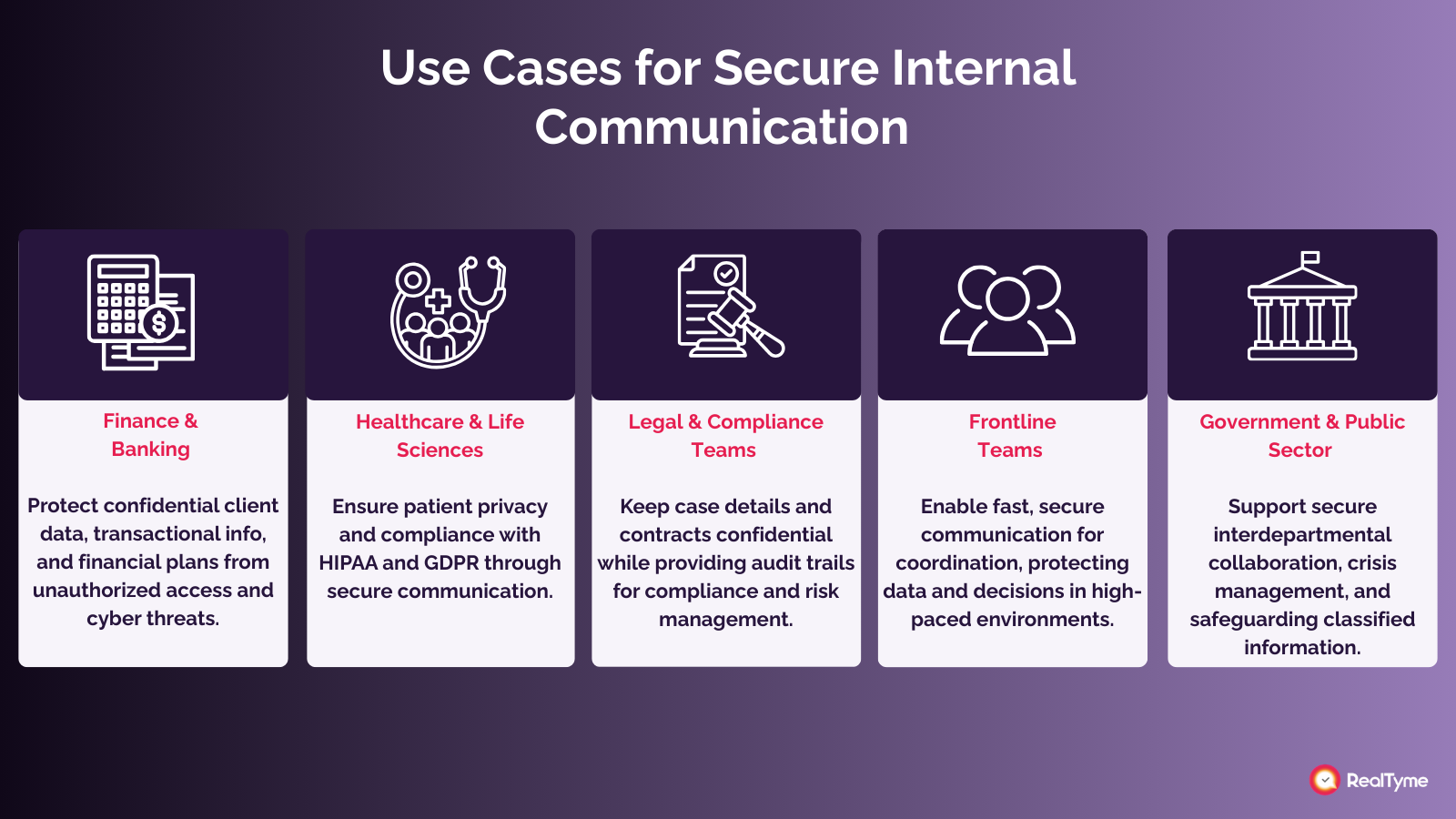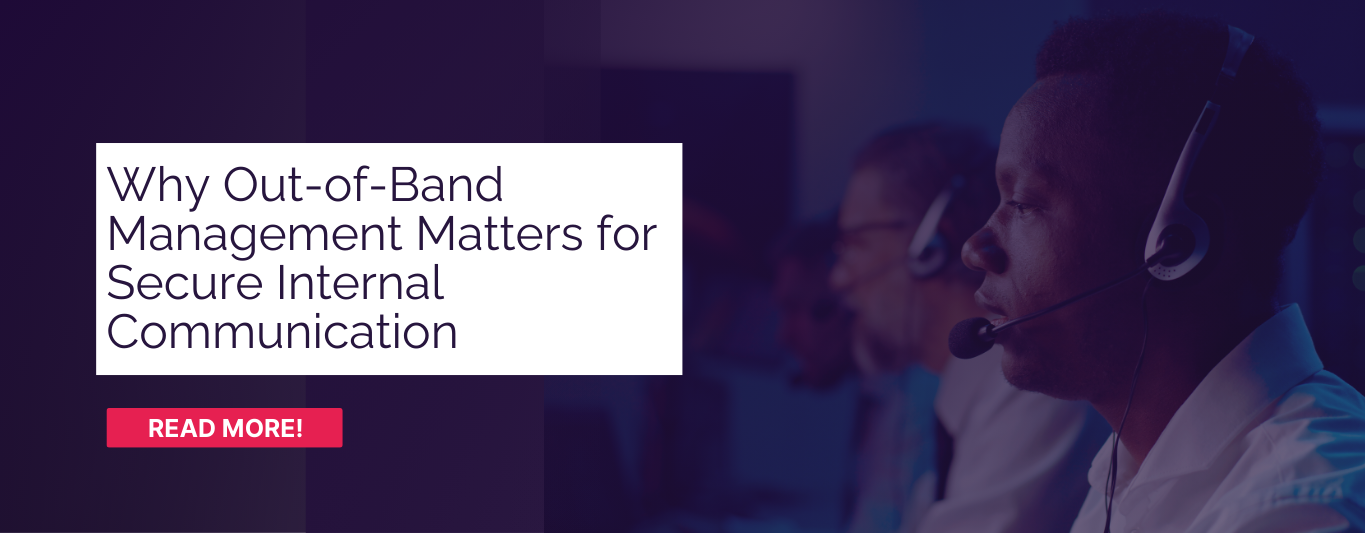10 Benefits of Secure Internal Communication for Businesses

Secure internal communication is the frontline defense against leaked files, phishing attacks, and intercepted messages. and the fastest way to protect your business from costly cyber threats.
These aren’t “what ifs”, but daily risks in the modern workplace. And they all have one thing in common: unsecured internal communication.
Today, secure internal communication and privacy-first communication tools play a vital role in protecting your organization from data breaches, compliance violations, and reputational damage.
As cyber threats grow more sophisticated, how your teams collaborate internally—through encrypted messaging and secure business communication platforms—can make or break your company’s cybersecurity defenses.
If your internal communication isn’t secure, your business isn’t secure.
Here are 10 key benefits of secure internal communication—from protecting sensitive data to boosting compliance, empowering teams, and preventing costly breaches.
Whether you’re in finance, healthcare, legal, or managing remote teams, these benefits will show you why encrypted, privacy-first communication tools are essential.
1. Protect Sensitive Business Data with Encrypted Messaging
One of the top benefits of secure internal communication is its ability to protect your most sensitive data from prying eyes. Financial reports, client records, intellectual property, all can be intercepted if you’re using unsecured channels like basic email or consumer messaging apps.
Encryption transforms your messages and files into unreadable code that can only be deciphered by intended recipients, effectively preventing hackers, insider threats, and third-party eavesdroppers from intercepting or tampering with your communications. This level of security is essential in a world where cybercriminals continuously develop sophisticated methods to exploit unsecured communication channels.

Protecting sensitive data with encrypted messaging includes:
- Implement end-to-end encryption (E2EE): Ensure that data is encrypted on the sender’s device and only decrypted by the recipient, leaving no readable data in transit or on servers.
- Use zero-knowledge platforms: Choose communication tools that do not store encryption keys, so even the service provider cannot access your messages.
- Enforce strong authentication: Protect access to communication apps with multi-factor authentication (MFA) to prevent unauthorized logins.
- Regularly update software: Keep communication platforms and devices up-to-date with the latest security patches to close vulnerabilities.
- Train employees on secure communication: Educate your workforce about phishing risks, suspicious links, and the importance of using approved secure channels.
By adopting encrypted messaging as a standard for secure internal communication, businesses can dramatically reduce the risk of data breaches, safeguard intellectual property, and maintain the trust of customers, partners, and employees.
2. Ensure Regulatory Compliance with Secure Communication Tools
With global data privacy laws like GDPR, HIPAA, and CCPA, organizations must handle sensitive information carefully. Secure internal communication platforms with built-in encryption and comprehensive audit trails help you meet these regulatory requirements effortlessly.
Using secure internal communication tools ensures that all messages and documents are encrypted, stored safely, and accessible only to authorized personnel.
Many secure communication platforms also provide compliance features such as data retention policies, user activity logs, and easy export of communication records to support audits.
Best practices for regulatory compliance include:
- Selecting secure communication platforms certified for industry compliance standards.
- Keeping detailed logs of communication activity for accountability.
- Implementing retention and deletion policies aligned with legal mandates.
- Conducting regular compliance audits and staff training on evolving regulations.
Embedding compliance into your communication system minimizes legal risks and proves your commitment to data protection.
3. Mitigate Insider Threats Through Role-Based Access and Monitoring
Insider threats, whether accidental or malicious, pose a significant risk to organizations. Secure internal communication platforms that support role-based access control (RBAC) ensure employees only access information necessary for their roles, minimizing data exposure.
Additionally, real-time monitoring and anomaly detection can flag suspicious behaviors early. Audit logs provide a traceable history of who accessed or shared sensitive information, increasing accountability.
Best practices to mitigate insider risks include:
- Set granular permissions based on job responsibilities.
- Monitor for unusual communication patterns or bulk data transfers.
- Use automated alerts for unauthorized access attempts.
- Deliver ongoing security awareness training
4. Enhance Crisis Management with Instant and Confidential Coordination
During a crisis, such as a data breach, legal investigation, or PR emergency, fast, secure communication is critical. Encrypted messaging platforms enable confidential, real-time coordination between crisis teams without fear of interception or leaks.
Secure channels ensure sensitive information stays within trusted parties, reducing the risk of misinformation or escalation. Having a dedicated secure communication protocol in place speeds response times and improves overall crisis outcomes.
Crisis communication best practices with secure internal channels include:
- Establish predefined secure communication channels for crisis teams.
- Train key personnel on using encrypted platforms during emergencies.
- Maintain updated contact lists and escalation procedures.
- Conduct regular crisis simulation exercises to test secure communication readiness.
With secure communication in place, you minimize misinformation, speed up response times, and protect your organization’s reputation.
5. Build Employee Trust and Promote Open Communication
Employees are more likely to share ideas, report issues, and collaborate openly when they trust that their conversations are private and secure.
Secure internal communication tools that guarantee confidentiality create a psychologically safe environment where staff feel valued and protected.
This trust encourages transparency and knowledge sharing, vital components of innovation and a positive workplace culture.
Fostering trust through secure internal communication:
- Clearly communicate security policies and privacy protections to all employees.
- Provide user-friendly secure communication tools accessible on all devices.
- Encourage a culture of respect and confidentiality in internal discussions.
- Offer regular training on privacy and security best practices.
A trusted, secure communication environment enhances employee engagement and drives business success.
6. Maintain Productivity by Avoiding Cybersecurity Disruptions
Cybersecurity incidents, such as data breaches or ransomware attacks, can bring business operations to a halt. Secure internal communication platforms help prevent these disruptions by protecting the channels teams rely on daily.
By using encrypted messaging and robust access controls, businesses minimize downtime caused by phishing scams or malware spread through unsecured communications. This ensures that teams stay connected and productive without interruptions.
Maintain productivity, include:
- Deploy secure communication tools that integrate seamlessly with existing workflows.
- Regularly back up communication data to prevent loss during incidents.
- Implement multi-factor authentication (MFA) to reduce unauthorized access risks.
- Educate employees on spotting phishing attempts and avoiding risky links.
With secure communication, your workforce can focus on delivering results, not dealing with avoidable security setbacks.
7. Support Global Teams with Cross-Border Data Privacy Compliance
Multinational organizations face complex data privacy laws that vary by country or region. Secure internal communication platforms help ensure compliance by encrypting data in transit and at rest, respecting data sovereignty and jurisdictional requirements.
By centralizing communication on compliant platforms, businesses can collaborate safely across borders without risking regulatory violations or data exposure.
Best practices for global compliance include:
- Choose secure communication solutions with data centers in compliant regions.
- Enable data residency options to store information within required jurisdictions.
- Implement consistent security policies across all locations.
- Train international teams on local data privacy laws and secure communication protocols.
This approach enables seamless, lawful collaboration while safeguarding sensitive information worldwide.
8. Safeguard Innovation and Intellectual Property
Your company’s intellectual property (IP), including product designs, trade secrets, and strategic plans, is an asset that must be protected at every stage.
Secure internal communication tools with end-to-end encryption and strict access controls prevent unauthorized disclosure of proprietary information.
Keeping IP secure prevents competitors or malicious actors from gaining unfair advantages and preserves your company’s competitive edge.
Protecting innovation include:
Restrict access to sensitive projects based on roles and need-to-know.
- Use watermarks or digital rights management (DRM) for shared documents.
- Monitor communication channels for suspicious sharing or downloads.
- Regularly update security protocols as projects evolve.
By safeguarding IP through secure communication, you protect your company’s future growth and innovation.
9. Reduce Financial and Reputational Costs of Data Breaches
Data breaches resulting from insecure internal communication can lead to hefty fines, legal liabilities, and lasting reputational damage. Investing in secure communication tools dramatically lowers the risk of breaches and their associated costs.
Prevention is always more cost-effective than remediation. Encrypted messaging and comprehensive monitoring help detect and stop threats before they escalate.
Best practices to minimize breach impact include:
- Conduct regular security risk assessments focused on communication channels.
- Enforce strict encryption and authentication standards.
- Develop incident response plans that include secure communication protocols.
- Maintain cyber insurance policies tailored to communication risks.
These steps help businesses avoid costly data breaches and maintain stakeholder trust.
10. Foster a Culture of Security Awareness Across Your Organization
Security is everyone’s responsibility. Embedding secure communication practices into daily workflows promotes a culture where privacy and data protection become second nature.
When employees consistently use security tools and understand the importance of protecting information, your organization’s overall cybersecurity posture strengthens significantly.
Security-conscious culture include:
- Provide ongoing training on secure communication and phishing awareness.
- Encourage reporting of suspicious activities without fear of retaliation.
- Recognize and reward secure behavior and adherence to policies.
- Lead by example—ensure management uses secure communication channels consistently.
A culture of security transforms your workforce into your strongest defense against cyber threats.
Use Cases for Secure Internal Communication

From finance to remote work, secure internal communication is a must-have across industries. Protecting sensitive information while enabling seamless, real-time collaboration is essential to maintaining trust, compliance, and operational efficiency.
Below are key use cases that highlight how encrypted messaging empowers organizations to meet these challenges head-on:
1. Finance & Banking
Financial institutions manage vast amounts of confidential client information, transactional data, and strategic financial plans. Secure internal communication safeguards sensitive data from unauthorized access and cyber threats.
It also supports compliance with industry regulations such as PCI DSS and SOX, while protecting against fraud and insider risks that can have costly consequences.
2. Healthcare & Life Sciences
Patient privacy is paramount in healthcare. Providers must comply with strict data protection laws like HIPAA and GDPR, making secure communication vital for protecting sensitive health information.
Encrypted messaging facilitates confidential, real-time collaboration among medical teams and administrative personnel without compromising patient confidentiality or regulatory compliance.
3. Legal & Compliance Teams
Legal professionals routinely handle privileged and highly sensitive information, including case details, contracts, and regulatory submissions.
Secure communication platforms ensure these discussions remain confidential and provide detailed audit trails necessary for compliance, risk mitigation, and maintaining attorney-client privilege.
4. Frontline Teams
Frontline teams are the face of your business, often working in dynamic, high-pressure environments. Secure internal communication enables these teams to share critical updates, coordinate operations, and respond quickly without risking sensitive information.
Encrypted messaging protects customer data, operational plans, and real-time decisions from interception or leaks, ensuring frontline staff can act confidently and efficiently while maintaining compliance and security standards.
5. Government & Public Sector
Government agencies and public sector bodies require secure communication for interdepartmental collaboration, crisis management, and safeguarding classified information.
Encrypted internal communication bolsters operational security and helps maintain public trust by ensuring sensitive data is protected against cyber threats.
6. Global & Remote Teams
With the rise of remote and distributed workforces, organizations face complex challenges around cross-border data privacy and regulatory compliance.
Secure communication platforms featuring end-to-end encryption and data residency controls enable global teams to collaborate seamlessly while respecting local data protection laws.
7. Crisis Management & Incident Response
During security incidents, data breaches, or operational crises, speed and confidentiality are critical.
Secure messaging channels allow crisis management teams to communicate rapidly and discreetly, reducing risk exposure and enabling timely, coordinated response to mitigate impact.
Final Thoughts: Secure Your Internal Communication, Secure Your Business
Protecting your internal conversations is both a security necessity and a competitive advantage.
By adopting privacy-first, encrypted communication tools and embedding a culture of security awareness, your organization not only safeguards sensitive data but also empowers teams to collaborate freely and confidently.
At RealTyme, we understand that true security means never compromising usability for privacy. Our secure communication platform is designed to keep your business conversations private, compliant, and seamless so you can focus on what matters most: growing your business with peace of mind.
Ready to strengthen your business with the most trusted, user-friendly secure communication solution?
Contact us today to schedule a personalized demo and discover how we can help protect your organization’s most valuable asset, its conversations. Or, join our community and gain exclusive access to dedicated training programs that boost your team’s security awareness and communication skills.
Don’t wait for a breach to expose your business. Secure your internal communication today.


